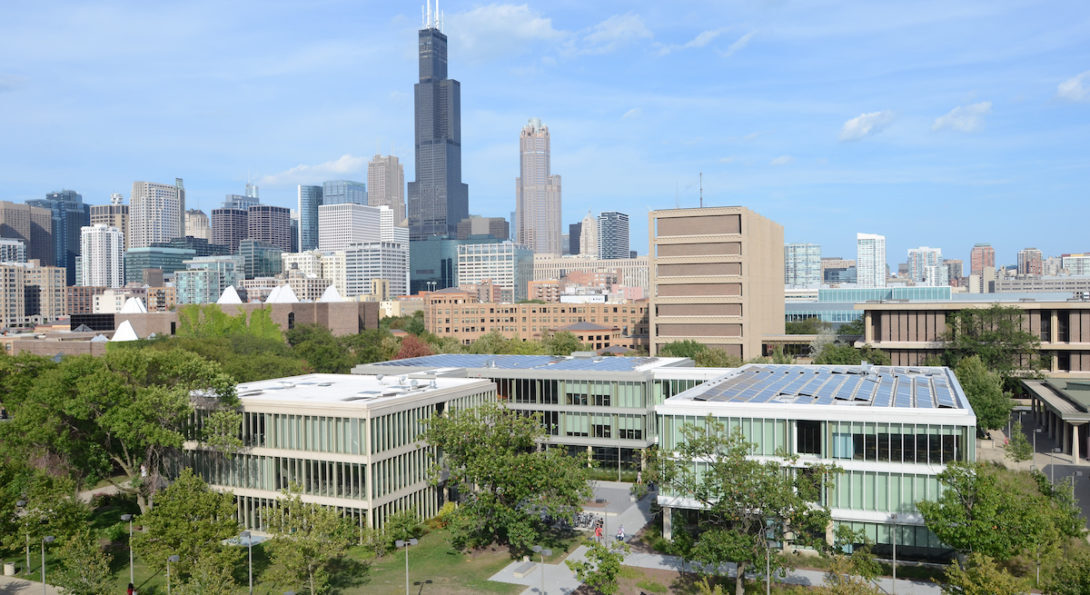Green Buildings

LEED requirements
New construction and major renovations must be LEED rated. Buildings are a significant source of emissions and and an opportunity for UIC to address its commitment to become a carbon neutral university.
When the campus was constructed in the early and mid-twentieth century, energy-efficiency was not as much of a concern to architects and designers as it is today. Retrofitting UIC's current inventory of buildings to be as energy efficient as possible is a key strategy in reducing our GHG emissions, electricity and operations cost.
In support of this strategy, UIC has committed to making sure that all new construction and major renovations costing $5 million or more have an aspirational goal of being certified at the LEED Silver level (Leadership in Energy and Environmental Design) by Green Business Certification Inc. Projects less than $5 million should comply with the LEED Gold requirements to the greatest extent practical including those credits UIC requires as mandatory, as they appear in the UIC building standards and meet the requirements in Climate Action Implementation Plan checklist. This will ensure new buildings and major renovations will be resource efficient, reduce waste, cost the university less to operate, use sustainable building materials, and have a high level of indoor environmental quality.
Academic and Residential Complex (ARC) Heading link
The ARC was certified LEED Gold in March 2020. It is a residence hall and classroom facility that was designed with the UIC Climate Commitments in mind. The ARC’s large windows allow natural daylight and help UIC reduce its carbon footprint. The classroom side of the building has recycling stations with single-stream collection bins to help achieve UIC’s Zero Waste Goal. The native plant rain garden landscaping techniques reduce stormwater and attract pollinators, supporting both UIC’s Net Zero Water and biodiversity goals. Read more about ARC’s building and design.
College of Medicine Learning Center Heading link
The College of Medicine Learning Center is a renovated space in the College of Medicine West building for 21st century medical students that includes naturally-lit classrooms and meeting spaces, collaborative study areas and energy-efficient systems. There is little need to ever turn on the lights. Even on a dreary December day, 75 % of the space still enjoys natural sunlight to illuminate studies. Discover how the College of Medicine improved student success through sustainable design.
Douglass Hall Heading link
Douglass Hall, home of the College of Business Administration, is the second building on UIC’s campus to gain a LEED® honor by receiving Gold certification. Douglass Hall shares the geothermal ground source heat pump system with Grant and Lincoln Halls. Douglas Hall’s solar panel system was partially funded by a generous grant from the Illinois Clean Energy Community Foundation. Learn more about how Douglass Hall earned LEED Gold, including using sustainable building materials and landscaping.
Engineering Innovation Building Heading link
The Engineering Innovation Building (EIB) was designed to be sustainable and earned LEED® Gold certification in 2021. The building was constructed on top of a parking lot, so no green space was lost. Native landscape design and shade trees support UIC’s Net Zero Water and Biodiverse Campus goals while adding the beauty of nature to campus life. The building’s exterior façade assembly is designed to help lower the urban heat island effect common in urban areas, allow for great daylighting and views into every office, lab, administration areas, and student lounge.
Grant Hall Heading link
Home of the UIC Writing Center, Grant Hall is the first building in the University of Illinois system to utilize geothermal heating and cooling, funded by Illinois Clean Energy Community Foundation. The Grant Hall project served as a successful test case to prove the value of sustainable and green building design on the UIC campus. The system provides significant energy cost savings and has been scaled to include Lincoln and Douglass Halls. While this project did not seek official LEED® certification, the renewal demonstrates and implements sustainable design strategies beyond structural reuse.
Window upgrades and glazing increase indoor exposure to natural light and exterior views to 99% of regularly occupied spaces. Directional daylight shading management controls light intensity for maximum comfort in the learning environments. Interior materials include low-VOC (Volatile Organic Compound) finishes and high recycled-content furniture, and the native or drought-tolerant species used in the site landscaping do not require an irrigation system.
Lincoln Hall Heading link
The University’s first LEED®-certified building in 2010, Lincoln Hall earned enough points to qualify for Gold certification in LEED for New Construction (LEED-NC). Energy-saving features include a geothermal system that uses the earth’s constant temperature to heat and cool the air in the building, solar photovoltaic panels that produce energy, solar film with a high reflective factor that helps keep the room cool in the warm months and heated in the cold months and window shades that increase energy savings by opening or closing with help from solar sensors and a building automation system.
Mile Square Health Center Heading link
Mile Square Health Center was designed with the goals of improving the health of people and our environment. It is the first entirely new building on campus to receive LEED® Gold certification. The Center is built on what used to be a badly polluted “brownfield” site. During construction it was cleaned of pollutants, putting back into use over 1½ acres of land that might have otherwise remained contaminated. Parking lots are built with light-colored permeable paving reflects light to reduce heat-gain and allows rainwater to soak into the ground, reducing stormwater run-off by 20%. This also reduces the need for chemical water treatment and improves water quality in the local rivers and lakes that provide drinking water. A portion of the roof on the third level is made with plants that hold rainwater, releasing it slowly into the storm sewers to help mitigate urban flooding. These plants also provide food and places for urban birds and insects to live while insulating the building, saving on heating and cooling costs.